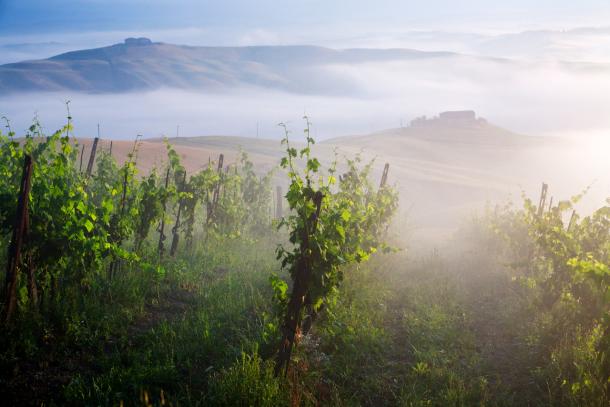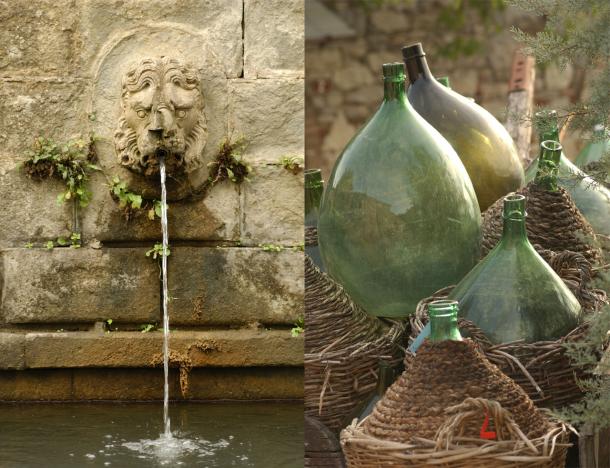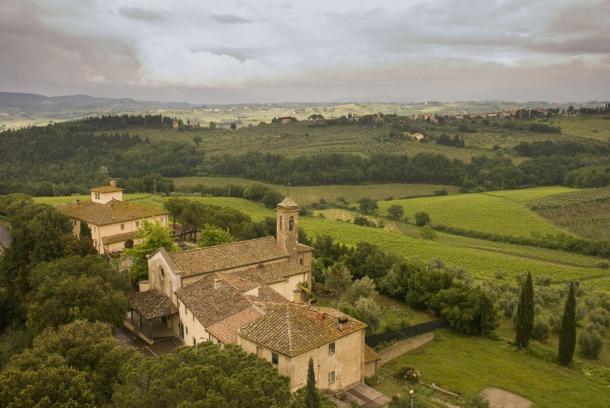The Wines of Tuscany (Toscana)
The name of Tuscany is synonymous with its most famous, and probably Italy’s most famous, red wine. Chianti is produced in high volumes and exported worldwide, with a distinctive personality that is difficult to define but that has somehow impressed consumers all over the world. The Sangiovese grape is the key to the region’s success, as the backbone of DOCG wines in Chianti, Brunello di Montalcino, Vino Nobile di Montepulciano and Carmignano. Yet the region’s prestige is today further enhanced by the evolution of the “Super Tuscan”, wines that now rank among some of Italy’s most refined. Failing to slot into any existing DOC or DOCG category, they are now largely classed as Toscana IGT in order to avoid the humble Vino da Tavola category.

Chianti is made in eight zones around the prized Classico area. It is thought that the rugged terrain and diversity of soil and climate add to the wine’s personality. The best winemakers are striving to make individualistic wines and consequently it is hard to pin down the nature of the quintessential Chianti. Much of the wine produced is still light and fresh and intended for early consumption. Yet beyond this easy-drinking style there are some oak aged, full-bodied and complex variations that develop in bottle into some of Italy’s most exciting wines. The Classico region is considered to be the best and its producers use a black rooster symbol to identify this quality.
Some Chianti estates will mention a particular vineyard to indicate a wine that is a cut above the rest. Yet it is the quality of the Sangiovese grape that plays the most important role. Wines made from Sangiovese tend to be rich in body and well scented of black and red cherries. The grape is highly versatile and responds well to oak ageing although some versions are designed for immediate drinking. Historically there has always been a practice of using a small amount of white grapes in the Sangiovese blend. This fell out of favour in the 1970s. Since then red grapes have been used to make up the blend in wines that are not 100% Sangiovese. In modern wines this can be international grapes such as Cabernet Sauvignon.

The wines from Brunello di Montalcino have gained considerably more stature than Chianti. The DOCG zone is around Siena and its wines tend to be more expensive than its counterparts from Chianti. Brunello is made from a particular clone of Sangiovese and is designed for medium to long-term cellaring in order for its true flavours to emerge. Rosso di Montalcino is also made here, a Sangiovese-based wine whose structure is less rigid, so the wine needs considerably less time in bottle. A sweet white called Moscadello di Montalcino is also made from Moscato grapes, and further wines are produced under the Sant’Antimo appellation. Today there are more than 200 labels for Brunello, representing the large and small estates that have made the wine historically. Additionally, some international corporations are now involved in production.
Vino Nobile di Montepulciano is made with another clone of Sangiovese called Prognolo Gentile. The wine was named “king of all wines” by the poet Francesco Redi in the 17th century and the “nobile” was added to the name in reverence to its esteem among nobility. Although the wine slipped out of the spotlight for several decades, it is once again impressing consumers worldwide under its DOCG. As in Brunello, a DOC Rosso di Montepulciano wine is released as a more approachable alternative that does not require ageing. Carmignano has also impressed nobility historically. The Grand Duke of Tuscany, Cosmo III de’ Medici, considered the wine to be one of Tuscany’s finest and granted it legal protection in 1716. Carmignano is a blend of Sangiovese with Cabernet Sauvignon, which was popular long before the Super Tuscan wines, many of which use the same practice, ever existed. The DOCG is for the red blend, and there is also a DOC for red, rosé and Vin Santo called Barco Reale di Carmignano. Blending is also practiced in Pomino, in which Sangiovese is blended with Cabernet and Merlot. A fine white containing Chardonnay and Pinot is also produced. Yet these fine wines lack the “cult” status of the Super Tuscan wines.
The first Super Tuscan was Vigarello, released in 1968, and other wine makers followed the trend of using 100% red grapes, instead of adding white grapes in the blend, introducing Merlot and Cabernet Sauvignon as the other ingredients. Sassicaia was the most groundbreaking wine, made from 100% Cabernet Sauvignon, and proving beyond any doubt that the Italians could make a modern red capable to compete with the best of its kind from anywhere in the world. It has since been granted a DOC as Bolgheri. Tignanello, a blend of Sangiovese and Cabernet, marked a departure from the practice of using large, Slavonian oak barrels, which was common in the region. Small barriques, which were considered far superior, were used instead for ageing the wine. Blends that had a higher proportion of Cabernet than Sangiovese followed, and then reds from Syrah, Merlot and Pinot Nero began to emerge.

There are many up and coming appellations in Tuscany, such as Morellino di Scansano DOCG where Sangiovese is important. Val di Cornia, Montecucco, Monteregio di Massa Marittima and Terratico di Bibbona also show promise. Winemakers along the coast are working with Cabernet and Merlot to make wines that challenge those from Bolgheri in terms of quality. Vin Santo has DOC status in many parts of the region. Much of it is made from Malvasia and Trebbiano, although a small amount known as Occhio di Pernice is also made from red grapes. Tuscan dry whites do not command the reputation of the reds, although Vernaccia di San Gimignano DOCG stands out as the region’s best white. The Vermentino grape thrives in the hills along the coast and some fine wines are coming to the forefront. International varieties are also showing promise in cooler parts of Tuscany, such as Chardonnay, Sauvignon Blanc and Pinot Grigio.
Tuscany DOCG wine appellations:
Brunello di Montalcino, Carmignano, Chianti, Chianti Classico, Elba Aleatico Passito or Aleatico Passito dell’Elba, Montecucco Sangiovese, Morellino di Scansano, Vernaccia di San Gimignano, Vino Nobile di Montepulciano
Tuscany DOC wine appellations:
Ansonica Costa dell’Argentario, Barco Reale di Carmignano or Rosato di Carmignano or Vin Santo di Carmignano or Vin Santo Carmignano Occhio di Pernice, Bianco dell’Empolese, Bianco di Pitigliano, Bianco Pisano di San Torpè, Bolgheri and Bolgheri Sassicaia, Candia dei Colli Apuani, Capalbio, Colli dell’Etruria Centrale, Colli di Luni, Colline Lucchesi, Cortona, Elba, Grance Senesi, Maremma Toscana, Montecarlo, Montecucco, Monteregio di Massa Marittima, Montescudaio, Moscadello di Montalcino, Orcia, Parrina, Pomino, Rosso di Montalcino, Rosso di Montepulciano, San Gimignano, Sant’Antimo, Sovana, Terratico di Bibbona, Terre di Casole, Terre di Pisa, Val d’Arbia, Val d’Arno di Sopra or Valdarno, Val di Cornia, Valdichiana, Valdinievole, Vin Santo del Chianti, Vin Santo del Chianti Classico, Vin Santo di Montepulciano
Tuscany IGT wine appellations:
Alta Valle della Greve, Colli della Toscana Centrale, Costa Toscana, Montecastelli, Toscana or Toscano, Val di Magra
Learn more about:
The Food and Cuisine of Tuscany (Toscana)
